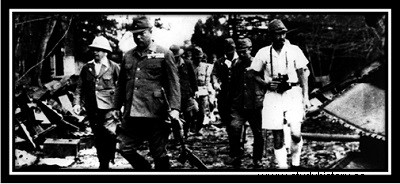
During the afternoon of December 2, 1941, the General Staff of the Japanese XXVth Army and Lieutenant-Colonel Kera, responsible for the transport of troops, scanned the sea from their headquarters in the port of Samah, in the island of Hai - Nah, off Indochina. Twenty transports were expected to embark the troops destined for the invasion of Thailand and Malaya, and so far only three had arrived.
The ships came from Japanese ports but also from Shanghai, Guangzhou and Formosa. It was impossible to know if their officers had misunderstood the orders or if they had encountered any difficulties. As all radio communication was prohibited, Kera telephoned the various bases without obtaining precise information. Anxiety was growing. But just before sunset, small smoke mages were spotted at various points on the horizon and ships began to show up. By noon on December 3, they were all in port, and the embarkation of the first units of the XXV Army and the 3rd Air Group took place as planned.
There were only two incidents:the first, when Kera saw some young officers of the 3rd Air Group trying to carry away iron bedding, bathtubs and sofas; the second, when General Yamashita, army commander, insisted on boarding one of the lead ships. But these incidents were quickly settled and, on the morning of December 4, the men and their equipment, guns, ammunition and food were on board. The operation could begin.
At that time, although Japan had been fighting in China since 1931 and had occupied Indochina in July 1941, it was not at war with either Britain or the United States. Yet negotiations on the trade embargo had all but failed and it was at the point where, barring last-minute concessions from the Americans, hostilities would open in the early hours of Sunday
December 8. The great chiefs were free to decide themselves the hour when they would launch their troops to the attack; they were only asked to achieve their goal at the scheduled time. This is why, if Yamashita embarked his troops on the 4th, other forces did not set out until the 5th or 6th, and the aircraft chosen for the attack on Pearl Harbor did not leave until the night of the 7th. There was, of course, no question of an official declaration of war.
Yamashita received his final orders on the evening of December 2:
• Top of military operations set for December 8;
• The XXVth Army was to cooperate with the Navy to launch operations aimed at the occupation of Malaya;
• The army commander had to follow the above orders. However, if the US-Japan negotiations were successful before that date, military operations would be suspended.
